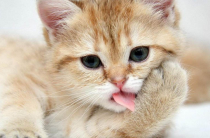It is not easy enough to find at least one person who would not have warm feelings for such an animal as a cat. These creatures constantly delight and amuse us, especially children. But cases of manifestation of unpleasant symptoms after the acquisition of such pets have become more frequent. Many complain of problems with the nose and eyes. This is nothing but an allergy. And then the question arises: how to cure an allergy to cats? This process can take a long time, so you need to gain strength and patience.
What causes allergies?
In society, it is generally accepted that allergies occur when cat hair is exposed to the mucous membranes of the human nasopharynx. I would like to dispel this myth. In the body of an animal, a protein is produced that our immune system, if it does not work properly, takes it for an allergen, and gives a reaction in the form of rhinitis, conjunctivitis, urticaria, cough, shortness of breath, and feeling unwell. This protein is distributed with the help of the saliva and urine of the pet everywhere: carpets, dishes, furniture, interior items, clothes. From this it follows that it is not wool, as such, that provokes reactions. And even having acquired a hairless cat breed, you cannot be insured against this disease.
If your cat or cat periodically go outside, you are definitely at risk. Dust and plant pollen brought home by your pet will definitely come to grips with your body. The cause of the disease may be a hereditary predisposition. Various diseases (infectious, viral, chronic) lead to a significant decrease in immunity, which subsequently is not able to recognize the allergen and reacts to any components (even harmless ones). Liver dysfunction can weaken the protective reactions of the body. This organ filters out all harmful substances and prevents the accumulation of toxins. If it does not work properly, intoxication of the body occurs.
Having a lot of dust in your home can undermine your health and speed up the onset of allergy symptoms. Strange as it may seem, but even the food we are used to can play a cruel joke. When interacting with cat proteins, they cause symptoms such as coughing fits and a rash on the surface of the skin. Even with aquarium fish, you need to be extremely careful.
Treatment of allergies with medicines
Before starting treatment, be sure to consult a doctor. Find out if the cat really caused such a reaction. To do this, it will be proposed to eliminate the pet for a while and monitor your body. If, after repeated contact with the animal, everything returns again, there is no doubt - this is an allergy to cats . For a more accurate result, be sure to pass the necessary tests. And based on the results, the most correct and rational treatment will be prescribed. It usually consists in the use of antihistamines, nasal drops and sprays, ointments, gels and creams.
Let's take a closer look at them. Antihistamines have three generations, each of which is more advanced than the previous one. So, the third generation has a minimum number of contraindications and adverse reactions, while the first is not shown to everyone. We invite you to take a look at them:
| Generation | Name | Characteristic |
| First generation | Diphenhydramine | It is used for any allergic reactions. Relieves hives and Quincke's edema. May cause drowsiness, tachycardia, gastrointestinal disturbances. It is strictly contraindicated during pregnancy, because it can cause uterine contractions. Not recommended for diseases of the liver and kidneys. |
| Suprastin | One of the safest drugs. The drug prevents the production of histamine in the cells. Eliminates rhinitis, skin rash and itching, conjunctivitis. May cause sedation. Contraindicated in bronchial asthma and pregnant women. | |
| Omeril | A strong antihistamine. The result of the action becomes noticeable within an hour after application. It is prescribed during the flowering period of the plant, with cold allergies, allergies to animals and house dust. Contraindicated in people suffering from diseases of the gastrointestinal tract, heart and liver. Not recommended during pregnancy. | |
| Tavegil | Helps to cope with such manifestations as eczema, any form of dermatitis, urticaria, cough and allergic rhinitis. Quite effective for Quincke's edema. After its use, drowsiness, increased fatigue, cardiac dysfunction, and nausea may occur. Not recommended during pregnancy and lactation. | |
| Second generation | ebastine | The drug retains its effect for two days. It is prescribed for allergic and chronic urticaria. It relieves the patient of nasal congestion and redness of the eyes. Eliminates attacks of dry cough. |
| cetirizine | Copes with symptoms such as hives, runny nose, lacrimation, Quincke's edema. Does not cause adverse reactions. Not recommended for impaired renal function. | |
| Astemizol | The drug is effective for all types of allergies. The effect of its use persists throughout the day. Does not cause a sedative reaction. Contraindicated in pregnancy and hypersensitivity to certain components. | |
| third generation | Hifenadine | Used by patients with any kind of allergy. Relieves symptoms within half an hour after application. During pregnancy, it is allowed from the second trimester. |
| Levocetirizine | In the treatment of allergic reactions, it can cause headache, dizziness and nausea. If the correct dosage is observed, such reactions do not occur. Not recommended for kidney problems. During pregnancy, it is allowed under the supervision of a gynecologist. | |
| Telfast | Quite a strong remedy. Contraindicated in pregnant women. It is prescribed for complications of allergies. Removes Quincke's edema. |
A common symptom of cat allergies is allergic rhinitis. Often, antihistamines alone are not enough. Therefore, it is recommended to use topical agents such as nasal drops and sprays. This group of drugs is divided into the following types:
- Hormonal;
- Vasoconstrictor;
- Not hormonal;
- Cromons;
- Means for washing the nasal cavity.
Hormonal and vasoconstrictor drugs are the most effective among all. The effect is noticeable from the first minutes. Interacting with the nasal mucosa, they help cleanse it and protect it from the spread of the allergen. But, due to its composition, which includes the hormones of the adrenal cortex, their long-term use is not allowed. The maximum period is a week. If this time is exceeded, the structure of the nasal cavity is disturbed and addiction to drugs occurs. This can provoke more serious diseases and difficult treatment. Available only in the form of a spray, since the drops are very difficult to dose correctly. These include:
|
|
|
Non-hormonal drops are also called antihistamines. They are quite safe and are intended for the treatment of allergic rhinitis. In chronic forms, it can be used for a long time. Among them are the following: Allergodil, Fenistil, Zirtek, Levocabastin and others.
Cromones have a peculiar immunomodulatory effect. Their action persists for a long time. Reduce the amount of discharge from the nose, eliminate itching in the nose. These drugs actually have no restrictions on the use and adverse reactions. Allowed for both children and the elderly. These include:
- Lumozol;
- Kromoheksal;
- Cromoglin;
- Cromosol.
Nasal rinses contain only sea water and salt, without any other chemicals. Therefore, they are absolutely safe. They contribute to the natural and systematic healing of the nasal membrane. Effectively release the cavity from sputum, and relieve inflammation. Also, these drugs prevent the re-penetration of the allergen. These are the following drugs: Humer, Aqualor, Aqua Maris, Marimer, No-salt, Quicks, Dolphin, Salin.
With complications from allergies to cats, acute urticaria and dermatitis often occur. Creams and ointments are used to get rid of them. These drugs can also be either hormonal or non-hormonal. Hormonal are prescribed during periods of exacerbation of skin manifestations, but not more than a week. It is undesirable to take them for pregnant women, as they can change the hormonal background due to their composition. These include:
|
|
|
Non-hormonal ointments are safe to use. They will help relieve the first signs of skin inflammation. These drugs effectively heal the affected areas of the body, do not allow scarring of wounds and ulcers. You can use the following ointments: Fenistil gel, Levosin, Panthenol, Bepanten, Psilobalm.
Folk recipes for getting rid of allergies to cats
How to cure an allergy to cats folk remedies? Everything is extremely easy and simple. At this stage in the development of civilization, people are increasingly resorting to alternative medicine in the treatment of allergies. Such methods are quite effective and have been tested for many decades. Use the following tips:
| Celery | Drink freshly squeezed juice from this plant daily. Also, they can drip nose with allergic rhinitis. |
| Zabrus | Zabrus are called plugs of honeycombs. The healing property of honey is not a secret for anyone. Therefore, it is recommended to chew zabrus daily. |
| Duckweed | A few spoons of small duckweed are poured with two glasses of vodka. The infusion should be hidden in a cool and dark place for five days. It is necessary to take several times a day, 18 drops, diluted with a few tablespoons of water. |
| Motherwort | Finely chopped motherwort should be poured with boiling water and insisted for two hours. Gargle with this infusion up to five times a day. They are also encouraged to bathe their pets. |
| Birch buds | It will be enough to take a spoonful of birch buds and pour water, about half a liter. Boil it all for 10 minutes. Consume about 100 grams four to five times a day, having previously strained the decoction. |
Populists recommend using dandelion juice to treat cat allergies. Collect as many leaves and stems of this plant as possible and grind them by squeezing the juice through gauze. Dilute with the same amount of water and boil. This drink should be consumed in the morning on an empty stomach. It is very useful to drink chamomile tea with the addition of mint leaves. It will help remove the allergen from the body.
To relieve rhinitis, you can prepare drops based on honey. To do this, take honey and water in the same amount. After mixing thoroughly, drip up to four times a day. Rinse your nose with a simple saline solution. Salt dissolves in a glass of water in the amount of one spoon. This recipe will get rid of excess phlegm and help heal nasal irritation. Drip your nose with aloe juice or Kalanchoe.
In the fight against hives, an ointment of glycerin and rice starch will help. These ingredients are thoroughly mixed and applied to the skin in a very thin layer. As a cream, you can use a mixture of aloe juice and petroleum jelly. It would not be superfluous to purchase white or blue clay at the pharmacy, add a couple of tablespoons of water and a few drops of lemon to it. This will quickly relieve inflammation and eliminate itching. Herbal baths are very effective. Nettle, chamomile, lemon balm, eucalyptus, hawthorn, mint, motherwort and others are added to the water in any combination. And coniferous-based baths will help get rid of not only skin manifestations, but also clean the upper respiratory tract with their vapors. If it is not possible to use natural ingredients, drip essential oils of eucalyptus, fir, spruce, pine and mint.
How to treat cat allergies in children?
For the treatment of children, the same medications are used. But you need to know the age limits so as not to aggravate the condition of the baby. Check out antihistamines for children:
- For babies up to one year old: Suprastin, Fenistil drops, Erius syrup.
- From one year to three years: Diazolin, Claridol, Lomilan, Clarotadin.
- Starting from three years: Diphenhydramine, Phencarol, Trexil, Kralisens, Lorahexal.
- For children from the age of six: Tavegil, Letizen, Cetirinaks, Tsetrin, Zodak.
- Children from 12 years old can use: Rupafin, Kestin.
To relieve urticaria, the use of the following non-hormonal ointments is allowed almost from infancy:
|
|
And to save the baby from a runny nose and nasal congestion, use only saline nasal rinses.
Diet as a Prevention of Cat Allergy
In order to avoid manifestations of allergies to cats, or at the first symptoms of it, it is necessary to follow a hypoallergenic diet. This will help restore the normal functioning of the gastrointestinal tract and normalize the protective function of the liver and immunity. You will need to forget about the following foods in your daily diet:
|
|
|
Your diet should consist of a variety of cereals (except semolina), vegetables and dietary meat (rabbit, turkey, beef). I advise you to cook meat dishes for a couple or in an oven. When cooking potatoes, immerse them in cold water for several hours. This will help get rid of the maximum amount of starch. Prepare yourself salads from fresh cucumber and white cabbage, seasoning it with olive or linseed oil.
Various vegetable broths and casseroles are allowed. Sometimes allow yourself to drink a glass of yogurt before going to bed. You can’t completely refuse dairy products, so feel free to eat unflavored yoghurts and bean curd. Goat milk has a huge amount of vitamins and minerals.
Adviсe
If an allergy to cats manifests itself in a severe acute form, you will need to get rid of the pet. If you are categorically against giving away the animal, and the symptoms are not pronounced, follow these tips:
- Bathe your cat regularly with a hypoallergenic shampoo;
- Don't let her go outside;
- Cat utensils and a toilet should be in a place where you spend a minimum amount of time;
- Feed the animal only high-quality food;
- Keep your pet out of your bedroom and on your bed;
- Wash bedding and clothes regularly by ironing them;
- Carry out daily wet cleaning;
- Get rid of carpets, soft toys, unnecessary souvenirs;











